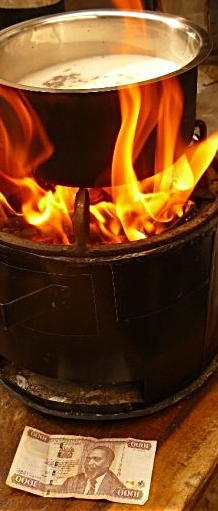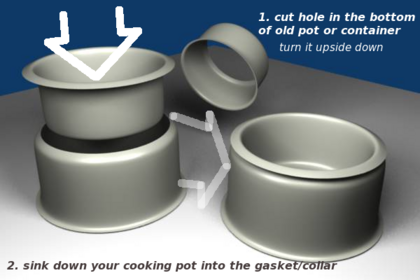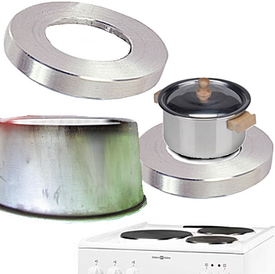(added first 3 recipes, tips & tricks) |
m (→Appliances & Equipment: spelling) |
||
| Line 33: | Line 33: | ||
Most advice here concerns mostly electrical equipment. | Most advice here concerns mostly electrical equipment. | ||
Every home have got some standard appliances like a fridge/freezer and an oven/stove (powered by gas or electricity) with 3-4 hotplates on top. Try to keep them clean both outside and inside, especially a freezer will be using lots more electricity | Every home have got some standard appliances like a fridge/freezer and an oven/stove (powered by gas or electricity) with 3-4 hotplates on top. Try to keep them clean both outside and inside, especially a freezer will be using lots more electricity if it got big chunks of ice and frost on the interior walls and shelves. Check the doors at least once a year to make sure that the isolation strips around the edge of the opening are clean, undamaged and closes tightly, any air that is released out from any gaps will cause the fridge to work more often. Fridge/freezers is a large portion of the energy costs in private homes. | ||
Some other equipment that is very useful and will help a lot is a microwave-oven and electric water kettle. You could even benefit from having 2 different sizes on kettles, one for occasions when you just want to have one or two cups of tea, and another one bigger for boiling larger amounts of water. The time and electricity used by the kettle depends on how much air it is inside the kettle when you boil water. | Some other equipment that is very useful and will help a lot is a microwave-oven and electric water kettle. You could even benefit from having 2 different sizes on kettles, one for occasions when you just want to have one or two cups of tea, and another one bigger for boiling larger amounts of water. The time and electricity used by the kettle depends on how much air it is inside the kettle when you boil water. | ||
Revision as of 20:04, 20 November 2010

People that live in undeveloped areas who have none or very little fuel, electricity, water, food, are highly creative. They struggle and try to get along with any means they can find for the day. Some of their smallest ideas - 'sometimes very simple tricks or methods that save water and/or energy' - could easily be transfered, applied to kitchens in developed nations. Even the tiniest of reduction of electricity, gas and water do make a visible change in the monthly/yearly utility bills, and can make the economy and lifestyle slightly better for individuals in all the developed nations.
There can be some people in industrialized nations in the north and west that sometimes can be taking for granted that the energy, electricity, water and food is relatively cheap, abundant, available and affordable to waste. As the prices on oil, diesel and gasoline rises, so will price on coal and electricity, and possibly the taxes on utility companies. So in order to prevent you from getting raised costs for cooking, here are some suggested, simple methods to help you cook much more efficiently.
The short-term purpose of this project
- start spreading information about possibilities with improved cooking methods.
- attempt to create broader understanding about what we have that others might not have.
- start to change minor routines and behavior among people to think in terms of solidarity and about their own use and waste. And that small amounts in many million homes will add up to a landslide.
- make people realize that any little second of saving electricity will be of help and will become visible on the slightly lower bill from the power company. (promoting the Nega-watt-thinking)
The larger perspective
- influence a bigger change among many individuals.
- make people start to save more percentage of electricity, time, water, energy.
- educate people how to shop smarter, cook more at home and to eat healthier.
- reduce the amount of appliances that is routinely installed into new homes.
- inspire many people to feel good about saving so they become eager to try to experiment to find many more energy-saving methods in their lives.
- inspire others to start similar efficiency-projects within other areas.

|

|
Illustrations on how you can build gaskets/collars to retain heat closest around the cooking pot. This works well over both open fire & modern electric stoves.
Appliances & Equipment
Most advice here concerns mostly electrical equipment.
Every home have got some standard appliances like a fridge/freezer and an oven/stove (powered by gas or electricity) with 3-4 hotplates on top. Try to keep them clean both outside and inside, especially a freezer will be using lots more electricity if it got big chunks of ice and frost on the interior walls and shelves. Check the doors at least once a year to make sure that the isolation strips around the edge of the opening are clean, undamaged and closes tightly, any air that is released out from any gaps will cause the fridge to work more often. Fridge/freezers is a large portion of the energy costs in private homes.
Some other equipment that is very useful and will help a lot is a microwave-oven and electric water kettle. You could even benefit from having 2 different sizes on kettles, one for occasions when you just want to have one or two cups of tea, and another one bigger for boiling larger amounts of water. The time and electricity used by the kettle depends on how much air it is inside the kettle when you boil water.
Two or three different sized boiling sauce pans with lids. The lid should fit tight around the top to avoid any heat and steam to leak out. Use only pans that is perfectly flat bottomed (and thickbottomed) the better contact with the hotplate results in faster heat, shorter cooking time and less waste. One or two frying pans is also good to have. Try to always match the size of the pan to the range used on the stove, if you can see any part of the hotplate outside the edge of the pan you will waste a lot of heat. Some large frying pans come with lids, which can come in handy in other cooking, even if you normally use a frying pan for cooking stuff that don't need a lid.
Examples on updated, improved methods
Eggs, boiled
When you will boil eggs, think about how many eggs you want right away, and how many you might want for the next two days. Boiled eggs keep fresh in any normal fridge for at least 2-3 days. So by boiling a couple of extra eggs each time wont be any extra energy used, in fact it will keep you from having to boil eggs every day. This could reduce your energy use for boiling eggs with up to 50%.
Start with pouring cool water in the electric kettle and boil it. Remember to use as exact amounts of water as possible, for anything you boil. Filling with any extra will make the cooking time longer and need more electricity. Pick out a size of saucepan that will fit the number of eggs you want to cook. Do not fill any cold water in this saucepan, because you will only cool it down. Fill in little bit of tepid/lukewarm water in the bottom and place all your eggs in the pan, place it on a hotplate that is the same size of the bottom of the pan and turn on maximum heat. Pour in the hot water from the kettle. Sometimes it helps if you tilt the saucepan slightly towards you, so the eggs will roll to your side and you can pour the hot water at the other side of the pan without making the eggshells crack with the sudden heat. Place the lid on the pan. Start a timer. Gradually lower the heat on the plate to keep an even boil, it should not need to cook too hard. If you have turned down a bit too much, and it will stop boiling, you could turn it up one notch for a minute, to get it start bubbling again. There is a lot of heat getting stored in the hotplate and the bottom of the pan if the contact is perfect. So turn off the stove 3 minutes before your eggs are ready. That means for 6-minute eggs, the total time you use electricity is only 3 + the time it took for the kettle.
Oatmeal porridge
Oats is a great source of carbohydrates and energy as a breakfast. It is very fast to do, but this method is even faster, and will make you save more time on not having to wash up any pans or pots. Boil water in the electric kettle. (if you will need hot water for a cup of tea or instant coffe, boil that amount of water at the same time)
Place a ceramic deep dish or soup-plate onto a hotplate without turning it on! Pour one cup to one and a half cup of oats in the dish/plats. add a pinch of salt. Pour the boiling water from the kettle onto the oats and cover instantly with a lid from a sauce-pan or a fryingpan. Use whatever you got to cover, as long as it fits over the dish and retains the most of the steam inside, to cook and steam the oats. After 2 minutes lift the lid and stir around a little. Put the lid back on. Wait for 2 more minutes or until it is ready, put your favourite toppings on it and eat. (If it not is cooked properly you can add little bit of water and put the dish in the microwave and cook on low setting for 5-20 seconds)
Some examples on very tasty and healthy toppings are grated/shredded coconut, cinnamonpowder, applesauce, crushed hazelnuts, almonds, walnuts, dehydrated fruits like apricots or raisins. Experiment and mix. If you can come up with plenty of versions, you will not ever get bored with oat-porridge in the morning.
Cous-cous & Bulgur
These are two types of processed wheat, comes in different fine/large grains and are a good and energyefficient source of carbohydrates. The cooking times are extremely short, and a very healthy substitute for any types of carbohydrates that require long cookingtime. It can be slight difference in some different suppliors type of Cous-cous and Bulgur, but this is a general explanation of how to prepare it.
Boil water in the electric kettle. Place a glass bowl, ceramic deep dish or soup-plate onto a hotplate without turning it on! (make sure the glass bowl is thick and recommended for use in microwave-oven) Pour in the amount of couscous or bulgur into the bowl, add one to two pinches of salt. Pour water into the bowl, approximately two cups of water per cup of couscous. Cover the bowl with a towel and a lid. It should be airtight, and wrapping any textile towel around the bowl helps.
Leave it on the hotplate for 4-5 minutes, Bulgur takes an extra minute or two to be ready. It will cook/steam evenly without any use of electricity from the oven. Remove the lid, stir in your choice of spices and place the bowl on the table. (examples on tasty spice combinations and recipes for different couscous-salads will come later)
Tips and Tricks
Fridge
If you are removing a large chunk of ice or scrape away frost from the inside walls of the freezer, place it in a plastic container and put it into the fridge. The energy from it melting will spread in the air inside the fridge, causing the temperature to drop slowly, and the fridge will not need to use any energy at all until the frost/ice is completely melted.
If you are going to cook something tomorrow, that is in the freezer now, place it in the fridge on the evening before, making it start to defrost slowly over the night or even up to 30 hours. The fridge will not need to use any energy at all during that time the frozen object is colder than the thermostat setting. And you will not need to waste any hot water if you normally put frozen objects in the sink and pour hot water onto it. And it is very difficult to properly defrost meat and chicken with the microwave.
Freezer
If you are starting to change your eating habits so much that you primarily shop and eat fresh products and tinned goods, the need for having a freezer is gradually reduced. Some people can even get to the point where they can turn it off completely, and get use that space for storing pans and other kitchen utensils.
This is a project explanation (that will be edited)
At first this project is simply personal (for me, the user : Yeahvle ) but I would appreciate additions later on, from other users that have some inspiration from cooking in many undeveloped parts of the world. Primarily ideas that can be applied to modern kitchen equipment.
A personal ambition right now is to not mention anything about climate crisis, carbon footprint, environmental impact, side effects about waste or anything like that, that potentially could reduce the potential massive impact of this concept. I will use this mindset in a test to try if the focus of this project will be making it more easily adapted by everyone that is normally not interested in living green. I hope you will respect that ambition and follow along in my train of thought, for a while, it is only an effort of me to try to change the focus from the infected climate debate onto the solidarity to all other individuals living now and to those in the future.
I, Yeahvle, was originally thinking about writing a book on this topic, without telling it is really a promotion for sustainability and green living in modern world, but I would like the information to become spread as fast as possible, and to as many as possible, and I have no interest of personal profit from this project.
So, I will gradually fill it with information, recipes, methods and illustrations. I do not have a camera, so if you attempt to cook something using any of my methods I would be glad if you submitted your photos (small sizes please).
I hope this will be appreciated, used by many, and feel free to add your comments later on, as I progress. Because I want it to become well-known and spread to many, in order to help inspire and change behavior ever so slightly among many in north and western world.
And in a later stage I would like to have the opportunity to assemble this project entirely in a book form (both the information aswell as the notes and discussions about how it was created) that I will try to print copies and sell at different outlets (second-hand-shops, thrift-stores, used-clothes-markets)
So if you add something/anything to this project, I hope that you will agree with the terms of Creative Commons licence and that you will get no profit at all from your contribution as I plan to donate all future income from this project.
I know that I am mostly writing from a personal point of view. Please have patience with me, i am trying to edit this as soon as i get accustomed with the wiki. (So I will not try to edit or work on any other pages, until I get the lingua franca.)
--Yeahvle 19:59, 20 November 2010 (UTC)